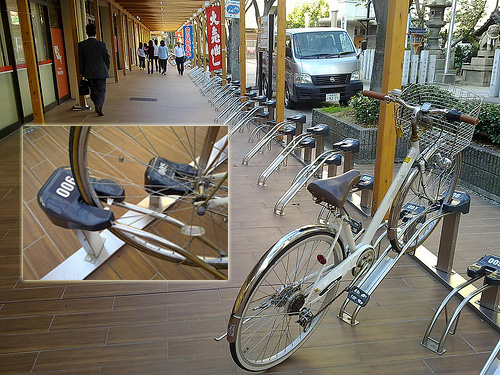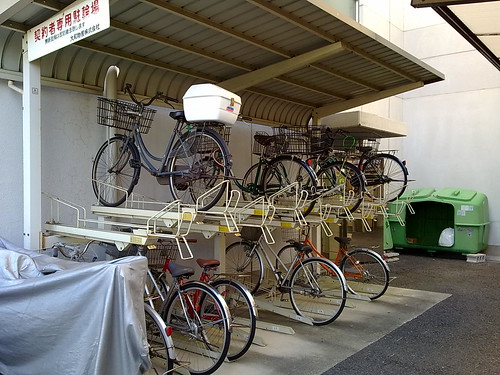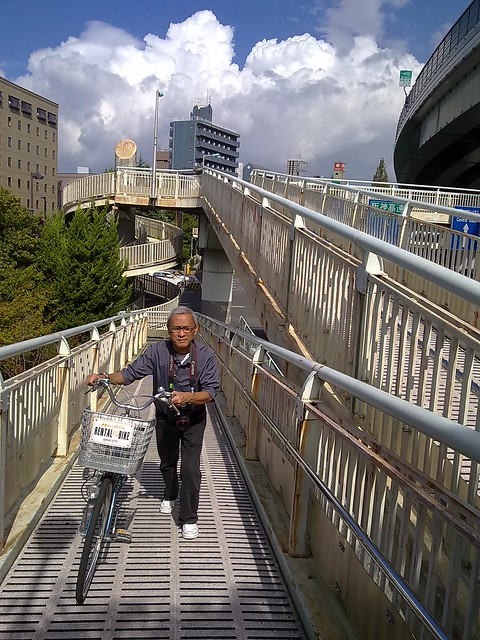If you're not from Japan, chances are you probably haven't heard of Sakai City. But you've probably heard of their bicycles. This modest industrial city of 840,000 residents, located just around 20 minutes from Osaka City, manufactures between 40 and 60 percent of the bicycles in Japan. It's also home to Shimano Industries, the world’s largest supplier of bicycle components. For bicycle geeks, this city is a cycling mecca.
Click here to view in full screen In car-crazy Manila, people who get around on bikes are often either considered eccentric or just can't afford to buy a car. But some of the world’s wealthiest cities – Copenhagen, Amsterdam, San Francisco, and many more—are also some of the most live-able cities in the world precisely because they have been built on a human scale with bike-friendly infrastructures. Bicycles, after all, are compact, clean, affordable, quiet, and a good way of getting exercise. Cities that are bike-able are less congested, less polluted, quieter, safer, and often more enjoyable to explore. Sakai City may not be the most well-known metropolis in the world or even in Japan, but its bike-ability is definitely world-class. In Sakai City, you can walk three blocks and see more bicycles than you would in thirty kilometers of any major city in the Philippines. The city government estimates that there are 1 million bicycles in Sakai—more than their population.
 Bikers pay a small fee to lock their bikes outside a shopping mall. Pia Faustino
Bikers pay a small fee to lock their bikes outside a shopping mall. Pia Faustino The ever-efficient Japanese like to maximize space by using double-decker parking facilities like this one. Pia Faustino
The ever-efficient Japanese like to maximize space by using double-decker parking facilities like this one. Pia Faustino During my trip to Sakai earlier this month, I made it a point to spend one cloudy autumn afternoon exploring the city on a bicycle. The first step, renting a bike, proved easy and cheap. You can rent a bicycle from almost any tourism office in the city for a modest price of only ¥240 (equivalent of PHP120 or $3) for an entire day. They've got all different types of bikes, too-- folding bicycles, commuter bicycles, and even electric bicycles. All you need to do is show your passport or international driver's license, sign a waiver saying you'll pay for the bike if you lose it, and off you go. After planning my route using a city map I got from the hotel front desk, I set off on a 5-kilometer bike ride to Daisen Park, at the center of the city. The temperature was perfect-- not too hot or cold, a bit like Tagaytay after a rainstorm. If in Manila, bikers have to don cycling shorts and dry-fit jerseys to keep from sweating like mad, Sakai’s cool weather allows for more versatility in the cycling chic department. In Sakai, it’s not uncommon to see suit-clad office workers or even women in heels and skirts riding bicycles. So I felt totally at ease biking in the same jeans and sweater I wore out to lunch. Plus, it’s safe enough in Sakai that you don’t have to wear a helmet.
 GMANews.TV Photo Editor Joe Galvez walks his bike up a ramp built to help cyclists cross one of Sakai's major highways. Pia Faustino
GMANews.TV Photo Editor Joe Galvez walks his bike up a ramp built to help cyclists cross one of Sakai's major highways. Pia Faustino But cycling fashion options aside, the truly best thing about biking in Sakai is that you don’t have to share the road with speeding, smoke-spewing cars. Unlike in Manila, where the government has focused its resources on building wider and better roads for motorists, the Sakai City government has invested in building spacious paths exclusively for pedestrians and cyclists. These bikeways and walkways run parallel to almost all major highways or streets. Crossing the street was made easy because of the designated crosswalks specifically for bikes. Stoplights are equipped with timers that tell cyclists and pedestrians exactly how many seconds to wait before it's safe to cross, lessening the impulse to try to “beat" the red light. When I reached a major intersection, I was pleasantly amused to find a long, winding ramp that enables cyclists to safely walk their bikes up and over the intersection. As an added bonus, it's a lot of fun to ride your bike back down the ramp once you cross to the other side. When cyclists have to bike alongside fast-moving cars, there’s rarely an opportunity to wander of course or take a break from the ride. But biking on the sidewalks of Sakai, I felt free to stop and savor the different places and things I encountered along the way. At stoplights, I would pause to take pictures of things that caught my eye—candy-colored bikes parked on the sidewalk, a graffiti-covered wall, a bridge overlooking a street canal, an elderly woman feeding pigeons.
 There are designated bicycle lanes and crossings all over Sakai City. Pia Faustino
There are designated bicycle lanes and crossings all over Sakai City. Pia Faustino If you feel like stopping somewhere for longer than a few minutes, there’s plenty of cheap bicycle parking all over the city. Many cyclists also just leave their bikes parked on the sidewalks, but there are also larger communal bike parking spaces that charge around ¥100 (roughly 50 pesos or less than $2) for an entire day. I was surprised to find bicycle parking even in the basement of a five-star hotel, complete with a ramp that lets you roll rather than carry your bike down the stairs. Cyclists should just be careful to avoid parking in prohibited areas, or else their bikes get impounded for a fine of 1,500 yen. As long as you find a safe place to park, one of the best places to stop in Sakai is Daisen Park, a 35-hectare green oasis in the middle of the city. I enjoyed walking along the paths, beneath the trees, and wandering into the Japanese Garden, a public garden designed in the traditional “Tsukiyama" landscape style. Biking visitors can also make their way to the Shin-An Teahouse, also located in the park, where they can enjoy a classic cup of “matcha" or green tea. But if you’re a hardcore bicycle geek, your trip to Sakai would not be complete without a visit to Sakai's Bicycle Museum, also in Daisen Park. Set up by Shimano, which is headquartered in Sakai, the museum houses hundreds of antique bicycles that chronicle the evolution of bicycle design over the past 200 years.
 Hundreds of vintage bicycles are on display at the Bicycle Museum of Sakai, including this 1897 Quintuplet Racer from the Netherlands. Pia Faustino
Hundreds of vintage bicycles are on display at the Bicycle Museum of Sakai, including this 1897 Quintuplet Racer from the Netherlands. Pia Faustino Exploring the exhibit, I couldn't help but feel a bit of reverence and awe, considering the journey of the modern bicycle. Maybe because the bicycle is so complete and elegant in its current form, we don't realize how many versions it underwent to eventually become the bicycle we know today. Many of these initial incarnations seem almost laughable now. I was especially amazed to ride a replica of the very first bike, a German design made in 1818 that doesn't even have pedals, and the "Boneshaker," the classic bike designed with a huge wheel in front to facilitate speed. For someone who lives in Manila, it's easy to envy people who live in a bike-friendly city like Sakai. Yet we can find some comfort in the thought that maybe, like the bikes of yesterday, today's Philippine cities are also just laughable incarnations on the way to evolving into something better-- and more bike-able!
- HS, GMANews.TV  GMANews.TV producer Pia Faustino rented a bicycle to explore Japan's "bicycle capital," Sakai City. Joe Galvez
GMANews.TV producer Pia Faustino rented a bicycle to explore Japan's "bicycle capital," Sakai City. Joe Galvez  Bikers pay a small fee to lock their bikes outside a shopping mall. Pia Faustino
Bikers pay a small fee to lock their bikes outside a shopping mall. Pia Faustino The ever-efficient Japanese like to maximize space by using double-decker parking facilities like this one. Pia Faustino
The ever-efficient Japanese like to maximize space by using double-decker parking facilities like this one. Pia Faustino GMANews.TV Photo Editor Joe Galvez walks his bike up a ramp built to help cyclists cross one of Sakai's major highways. Pia Faustino
GMANews.TV Photo Editor Joe Galvez walks his bike up a ramp built to help cyclists cross one of Sakai's major highways. Pia Faustino There are designated bicycle lanes and crossings all over Sakai City. Pia Faustino
There are designated bicycle lanes and crossings all over Sakai City. Pia Faustino Hundreds of vintage bicycles are on display at the Bicycle Museum of Sakai, including this 1897 Quintuplet Racer from the Netherlands. Pia Faustino
Hundreds of vintage bicycles are on display at the Bicycle Museum of Sakai, including this 1897 Quintuplet Racer from the Netherlands. Pia Faustino GMANews.TV producer Pia Faustino rented a bicycle to explore Japan's "bicycle capital," Sakai City. Joe Galvez
GMANews.TV producer Pia Faustino rented a bicycle to explore Japan's "bicycle capital," Sakai City. Joe Galvez


